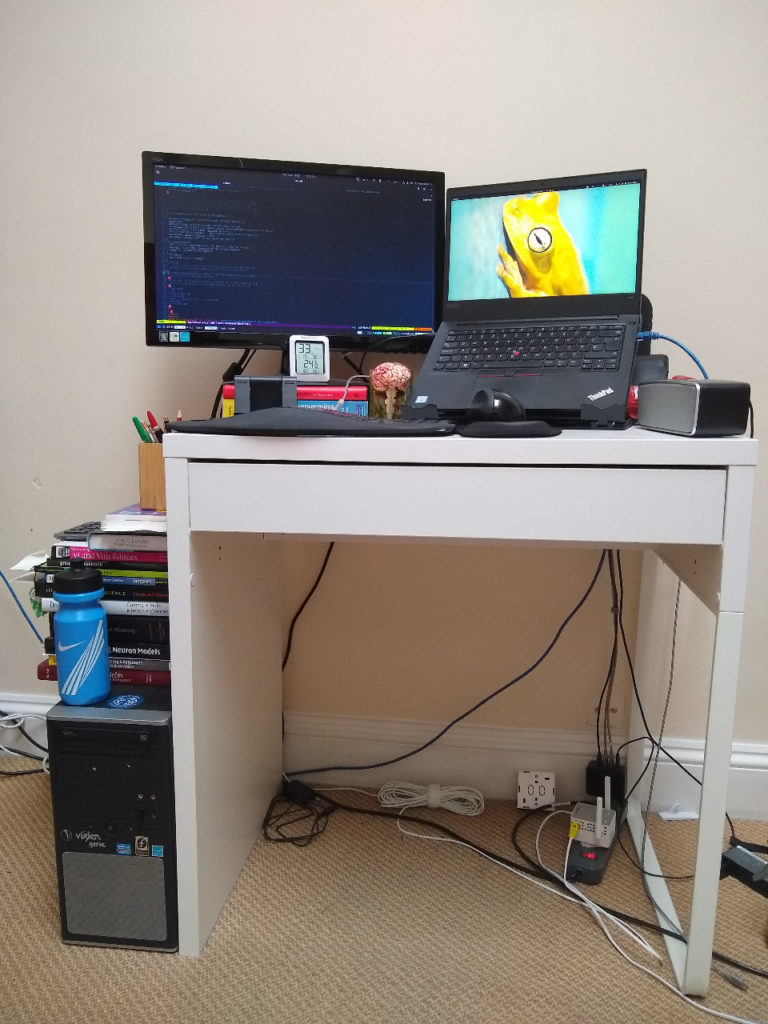We recently interviewed Ankur Sinha on how he uses Fedora. This is part of a series on the Fedora Magazine. The series profiles Fedora users and how they use Fedora to get things done. Contact us on the feedback form to express your interest in becoming an interviewee.
Who is Ankur Sinha?
Ankur is a Computational Neuroscientist and has just started his first post-doctoral fellowship at University College London and a FLOSS enthusiast trying to spread the message of FOSS and evidence based science. Ankur started using Linux a decade ago, when he was introduced to Linux in a LUG doing an install fest during his undergraduate degree.
Ankur loves reading:
“I read a lot and tend to get attached to characters from books quite easily. Holmes, Poirot (I’m a detective fiction fan), Francisco D’Anconia (fan of the book Atlas Shrugged, but not so much Ayn Rand’s philosophy), lots of random characters from books I’d read. I also read lots of Hindi comics as a child—Doga, Super commando Dhruv, Naagraj, and Chacha Chaudhary—loved them all!”.
As far as all time favorite movies go, Swades comes to his mind. His favorite genre is science fiction thrillers (think “The Prestige” and ” Predestination”). When not busy working or engaging people on IRC channels, he enjoys listening to podcasts and classic rock.
Ankur’s favorite food is his mother’s Chhole Bhature. Otherwise, if he’s away from home, his go-tos are Butter chicken, Butter Naan, and Chilli Chicken from North Indian restaurants.
The Fedora Community
Ankur found about Fedora after a distro hopping phase in 2008, and since then he has been a Fedora user. His first memory of the Fedora community is an IRC workshop on packaging fonts that the Fedora India community had organised back in 2008. Talking to and meeting other community members has been one of the most exciting parts of the Fedora community for him. “I found this great bunch of people to hang out and geek out with! It was so much fun, and extremely educational both in terms of technical knowledge and the social/philosophical side of FOSS and life in general.”
When asked what he would change in the Fedora Project if he could change one thing, he said that he prefers “Smaller tweaks” since “Smaller tweaks also allow work to be spread out, and that really helps”. Specifically, he would like to see more discussion on the philosophy and nuances of FOSS in the community.
"Perhaps we all know it so well that we take it for granted and focus on the work that needs to be done. It’s so easy to get bogged down in the work, though, that I worry that we forget the bigger picture sometimes. The end for us is to promote FOSS, and everything we do is the means to this end. So, I worry that the means sometimes becomes the end for us — that we focus so much on producing deliverables that we forget why we produce them."
Since he works in academia and science, Ankur would like the Fedora community (and FOSS in general) to get more involved with academic/scientific communities. “I think we have an excellent platform to enable education and research. NeuroFedora is a start in this direction.”
He wishes that other people knew that the Fedora community are not just OS developers, but a global community, and he’d like folks to just hang out and communicate even if they’re not contributing in the traditional sense of the word.
Ankur tries to help wherever he can, especially if newbies are involved. Nowadays, he tries to focus more on NeuroFedora as it fits well for his day-job and there’s so much to do in this Field + Open Science.
Ankur learnt most of the things from his >10 years of experience in Fedora and FOSS. He had learned theories of software development at undergrad but got to experience practical implementations from his colleagues in the community. He is a firm believer of “No question is a stupid question”. He adds that Fedora is perfect because it gets better as you start working with it.
His piece of advice for anyone thinking of getting involved in Fedora is to just go ahead and start. One doesn’t need to know anything at all. All of it can be learned over time. Secondly, don’t focus on tasks. Yes, that’s a good way of learning, but it is far more important to get to know the people of Fedora! As one meets more people, one learns more about how Fedora works and one has way more fun working and learning!!
Just like a lot of our community members, Ankur struggles from time constraints. His new challenge is to find more time to work on FOSS and Fedora. During his college years, it was to learn more and more.
One of the challenges Ankur faces about promoting open source is to explain to non-FOSS people that Windows/Mac aren’t the only OSes present. He thinks that having Fedora shipped with Lenovo systems will give a start for the community. It makes Fedora and FOSS more "official".
What Hardware?
Ankur has three machines and runs Fedora 32 on each of them:

- Thinkpad E490 laptop
- a custom workstation that university IT set up for research work
- a headless MacPro5,1
- 2x Microsoft Sculpt Ergonomic keyboard/mouse/numpad
- Netgear wifi extender
- TP-Link TL-PA8033PKIT AV1300 3-Port Gigabit Passthrough Powerline Adapters
- Moto g7 phone with Android 10
What Software?
Fedora 32 workstation, and server on the MacPro.
– Workstation/Gnome3 with a few extensions: caffeine, pomodoro,
– byobu with tmux: multiple sessions: default, work, fedora
– taskwarrior, vit, timewarrior, gnome-pomodoro, gnome-calendar/evolution for calendars
– neomutt with msmtp + offlineimap + notmuch for e-mail
– vim for *everything* possible – vimrc link
– qutebrowser, weechat, zathura, vimiv
– syncthing + dropbox + git for syncing/version control
For research work:
– NEST + lots of python and Gnuplot for analysis, LaTeX for writing
(stuff from NeuroFedora!)
– inkscape + gimp + dia + freemind for figures/mind mapping
– jabref for bibliography management
Other bits: – occasional gamer?
– Oad + endless sky + openttd!






Joao Rodrigues
Gets two 50 € mice;
Uses byobu, tmux, neomutt, vim, qutebrowser, wheechat, zathura, vimiv.
svsv sarma
I am glad to know that a doctor can use fedora for his profession. Has he contributed anything to fedora? Is he in the forum? As he found a place in this article, with 10 yrs of experience, he is a great help to the fedora users.
Tanishq Tejaswi
He isn’t a doctor in the clinical sense (if that’s what you meant). As the article says, he is a computational neuroscientist, and his profession probably requires him to work a lot on his computer.
Vipul Siddharth
Ankur has contributed in various fields and has initiated a bunch of things in the Fedora Project. He has mentioned a few of them in his wiki: https://fedoraproject.org/wiki/User:Ankursinha
Sean Connolly
Can we have more personal profiles like this, so that readers can contrast and compare Fedora usage in the community? I say this because my Fedora usage is quite different!!
SAME: F32, vim, python, gimp
DIFFERENT: XFCE (I hate Gnome), Thunderbird, private server (I hate “the cloud”)
NOT MENTIONED BUT USED HERE: dnf for version control, Wine for legacy Windows, sshd for system management across the network, LibreOffice, Chromium, Hugin, Xsane
Sebastiaan Franken
I’m curious about one thing you said. You use DNF as a version control tool? How did you pull that off? As far as I know DNF is a package manager, and git (or something like it) is for version control.
Leslie Satenstein
I would like to see a Fedora spin, for example, a rebirth of Korora Linux which included Fedora plus non-foss codecs, and other non Foss options so that a Fedora spin is a distro for everyone.
It is time that Fedora becomes a distro for everyone. I want to watch all types of videos, as an example.
Sebastiaan Franken
I’m guessing you intended to reply to the main article? Anyway, including stuff like that goes against the Fedora way, so to speak. Then again, they do make it quite easy nowadays to install this after you’ve done the OS install.
As far as I know there are legal reasons they don’t ship with every codec out of the box. Copyright laws, especially in the US, are funny that way. You can’t ship your OS with them, but it’s fine if the user installs them afterwards. This is why you get asked the question if you want to enable the 3rd party repositories when you start GNOME Software the first time in Fedora 32+
Sean Connolly
Sebastiaan: Version control for the Fedora boxes which I manage. Nothing to do with software version management — sorry if I should have used the phrase “configuration management”.
Sebastiaan Franken
Sorry, but this still isn’t clear to me. Again, DNF is a software tool, has nothing to do with configuration management as far as I know. The only configuration management DNF does is placing the config files for packages from the RPM’s you install through it in the required directory/directories, but that’s “package management”.
Configuration management, for me, is done with tools like Ansible. Maybe it’s a language thing/barrier here, but can you maybe explain it some more?
Ryan
‘vim for everything possible’: has VS Code on screen 😀
It’s always interesting to see how other people make use of Fedora. I personally started using Fedora all the way back at FC1 (technically began with RedHat 9 in tech college around 18 years ago). I have been part of the community for many years and have contributed in ask Fedora and in bug reports and in the docs team for a time during the asciidoctor transition.
If I was to answer the questions in the article, I am an IT professional and developer who has been in the industry for over 15 years. I use Fedora at work as well because it more closely represents the systems we are working with (RHEL) and I often promote the benefits of using a native Linux environment in my work functions to my colleagues.
In terms of my hardware:
Dell Inspiron 11″ 3180 (yes specwise it isn’t amazing, but it’s a great little casual laptop for when i need to quickly do some troubleshooting or jump into a video conference or do some casual browsing and it runs well with Linux installed)
and
Custom (old) build:
Intel i7 (3rd gen ivy bridge) 3770
Asus P8Z77-V mobo
1600 mhz 16 GB DDR3
2xSSD in RAID0 for the OS (128 Gb)
1x 2 TB HDD for storage
NVIDIA GTX1060 – currently using via pci passthrough to my gaming VM
Intel integrated graphics for daily use
Corsair H60 water cooling
Yes I am a gamer in case you were wondering, although haven’t had a lot of time for it since becoming a parent.
software:
Desktop: KDE
Functional (work related) software:
KRDC and Remmina (yes I have both, sometimes Remmina works better although I prefer KRDC)
VS Code (do a fair bit of python and ruby, and have dabbled with a number of other languages too)
Firefox
MS teams (flatpak)
Git
OpenSSH
OpenSSL
Essentials:
Amarok or Audacious
gimp
Libreoffice
Okular (although I have been known to use the flatpak of evince on occasion)
Akregator
KDE Connect
VLC
QEMU – virt-manager
Bitwarden (flatpak)
Kwrite
Filelight
Vim
Nextcloud client (flatpak)
Kdenlive
Audacity
OBS Studio
other software:
Wireshark
Chromium
Discord (flatpak)
Signal (flatpak)
Steam (flatpak)
Telegram (flatpak)
Zoom (flatpak)
KVirc
pulseeffects
Ardour
Kamoso
Inkscape
Games:
Frozen Bubble
Chromium B.S.U
Funguloids
0ad
supertux2
supertuxkart
lbrickbuster2
KMahjongg
Knights
Kigo
Kiriki
KPatience
KSudoku
Gweled
KNetwalk
Warmux
Steam games (I have most commonly played in Linux):
DOOM (before I setup pci passthrough)
Portal 2
Team Fortress 2
War Thunder
Ark Survival Evolved
As I mentioned earlier, I am a gamer so I play a lot more games than this, but these are ones that I have played the most within Linux.
Vipul Siddharth
It’s great to see how you make use of Fedora 😀
really enjoyed reading your comment.
p.s. what you see on Ankur’s screen is not VS Code but a well configured vim 🙂
Mohnish
As @Vipul mentioned, it’s not VS Code but Vim (notice the airline theme).
concerned user
All I do is play games through steam/proton (wine), but Fedora 32 makes it impossible to use Yuzu with Vulkan (as the available Qt5 version isn’t built with it) and in Fedora 33 (branched) it won’t even build or launch and neither snapd (cgroup v2 error) or flatpak (not maintained) builds work. I did try the latest Qt5 5.15.1 build from their testing repo, but it didn’t help – not looking good.